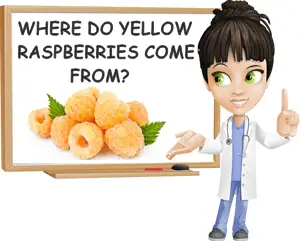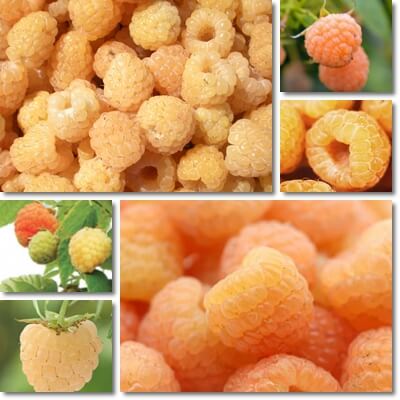Yellow raspberries, also known as golden raspberries, are in season right now and a healthy summer fruit to eat. But where do yellow raspberries come from? How did yellow raspberries come to be? Did they occur naturally? Are yellow raspberries genetically modified? Are yellow raspberries a hybrid? Do yellow raspberries come from red raspberries or black or purple? Or are they an entirely new species?
What are yellow raspberries?
Also known by the common name golden raspberries, yellow raspberries are a species of raspberry with fruit that are yellow to golden yellow in color when fully ripe. The exact color may vary between a lighter yellow to a deeper golden yellow color, sometimes with a peach tinge depending on the variety. Yellow raspberries are actually the second most common of all raspberry colors in commercial production, after red.

Are yellow raspberries GMO?
We’re used to raspberries being red so yellow raspberries are quite a big change, one that drives THE question: are they genetically modified? But no, yellow raspberries are not genetically modified.
The non-GMO quality of the yellow raspberry is evidenced by the existence of the yellow Himalayan raspberry, also called the golden Himalayan raspberry. Rubus ellipticus by its scientific name, the yellow Himalayan raspberry is a naturally occurring species of raspberry with yellow fruit.
The species has been documented since the 1800s and is native to most of Asia, having gradually been introduced to other parts of the world, quite successfully.
The yellow raspberry species occurs naturally in the wild without any form of human intervention.
With time, select cultivars of yellow raspberry have been developed to enhance some of the natural characteristics of the plant and its berries for a boost in commercial desirability. Modern-day yellow raspberry plants have been bred to produce a more plentiful crop as well as bigger fruit that are sweeter and more flavorful, firmer and juicier, and that come in a range of colors from a pale, almost translucent yellow color to a deep golden yellow to golden with peach tones.
Also see when is yellow raspberry season.

Where do yellow raspberries come from?
How did yellow raspberries come to be? Do yellow raspberries cultivated today come from the wild Himalayan yellow raspberry species or are they a different species of yellow raspberry? Have yellow raspberries as we know them resulted from the more common red raspberry or purple or black?
There are actually a few theories with regards to the origin of yellow raspberries.
Some cultivated varieties of yellow raspberry come from the naturally occurring species of Himalayan yellow raspberry, Rubus ellipticus. The species has been picked up for cultivation and, over time, bred to develop more commercially desirable characteristics (e.g. bigger fruit, more juice, firmer berries, sweeter taste).
The wild yellow raspberry being the direct ancestor of the present-day yellow raspberry makes a lot of sense and is a similar origin story to that of the red raspberry which has also been picked up for cultivation directly from the wild where it occurs naturally even nowadays. According to this theory, the yellow raspberry is an independent species, concurrent with the red raspberry.
Also see the benefits of eating yellow raspberries.
If you are looking to buy yellow raspberry plants for your home garden and shop around for them online, you might notice that it says on the label that the plants belong to the species Rubus idaeus. But Rubus idaeus is the common red raspberry, also called the European red raspberry. And it’s red, not yellow.
This references a second origin of yellow raspberries which is that yellow raspberries as we know them today don’t come from the wild yellow raspberry species, Rubus ellipticus. Or at least not all cultivated plants. Instead, they are the result of a natural mutation in the common red raspberry species, Rubus idaeus, that caused the ripe berries to no longer develop a red color.
In other words, yellow raspberries are more or less the same thing as red raspberries (same species), the only difference being they come in a different color.
This is actually a common occurrence in nature, foods losing their pigment naturally as a result of a spontaneous mutation. In the case of yellow raspberries, the presumed mutation caused the gene for the red color to become inactive or dormant, essentially leading to a discolored fruit.
Some say yellow raspberries come from the American red raspberry, Rubus strigosus. But the species is very closely related to the European red raspberry, Rubus idaeus, some saying it’s actually a subspecies (Rubus idaeus var. strigosus).
And lastly, some yellow raspberries come from black raspberries as the source species. According to this theory, a natural mutation in black raspberries blocked the production of dark anthocyanin pigments and caused yellow fruits instead of black. The same thing happened with red raspberries.
Some sources credit purple raspberries instead of black as the origin species of present day yellow raspberries, but this is seen as the least likely possibility. The purple raspberry is a cross between the red raspberry and the black raspberry, any two species of the two colors being able to hybridize naturally. A natural mutation in the purple raspberry causing changes in gene activity is credited to have resulted in discolored yellow raspberry fruit.
Also find out why are purple raspberries purple and what is the difference between purple, yellow and other raspberry colors.
What makes yellow raspberries yellow?
Yellow raspberries are a discolored variety of raspberry with yellow fruit instead of the more typical red color. Why are yellow raspberries yellow? Yellow raspberries exhibit a decreased capacity to produce dark anthocyanin pigments like other raspberry colors. Red, purple and black raspberries all produce dark anthocyanin pigments in generous amounts as they ripen.
Find out more about what makes yellow raspberries yellow.
What makes yellow raspberries yellow instead of red and other colors is both a lack of dark anthocyanin pigments and a high content of yellow carotene pigments. Due to their discoloration, the yellow pigments in the berries stand out more and color the berries accordingly.
